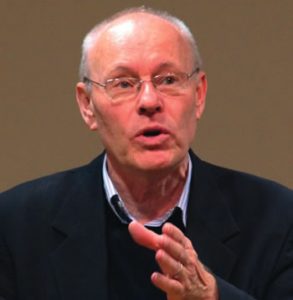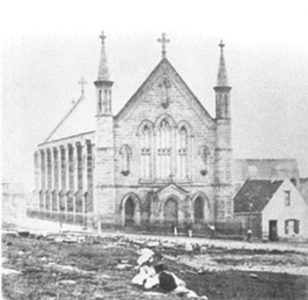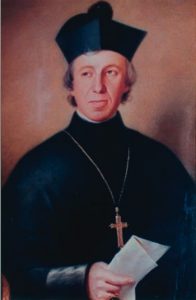St Patrick’s Church, Sydney (2)
Anniversary Year 2018

Fr Michael Whelan SM
The Irishman, William Davis, was sentenced to life in prison by the British in 1798 – without a trial. Being a blacksmith, he was automatically assumed to be someone who made pikes for the Irish ‘rebels’ of that year. Davis was one of one hundred and thirty-two ‘rebels’ who were deported as convicts to Australia in 1799. A Catholic priest – Fr Dixon – was deported on the same ship. Fr Dixon, under strict police supervision, celebrated the first legal Mass in the colony in May 1803.
William Davis continued his trade as a blacksmith in the colony. Again, this brought him under suspicion. He was deemed suspect by the magistrate, Rev Samuel Marsden – also known as the ‘Flogging Parson’. Davis was sentenced to 200 lashes, though it is uncertain whether this was carried out. It seems that Davis suffered much for the faith. However, by 1814 Davis was a free man and a landowner. The land he owned included that on which St Patrick’s Church was later built. He also received grants of land out near Campbelltown. The 1828 Census shows that he lived in Gloucester Street, owned 1700 acres of land, more than 100 acres cultivated, 700 head of cattle, 200 sheep and 5 horses. He was also one of the 37 founding members of the Bank of New South Wales – between them they purchased all 105 shares at £50 each. By 1840 he was a wealthy man.

The earliest known photograph of St Patrick's Church, taken by William Hetzer, c.1868 when the Marist Fathers were given care of the Parish.
In 1840 William Davis donated the land – part of his property – that St Patrick’s is now built on. Further, at the blessing of the foundation stone on 25 August 1840, he placed a cheque for £1,000 on the foundation stone. Fr Peter McMurrich writes:
“Following Davis’ donation of land, a committee was established to further the project at a public meeting held at the Castlereagh Street courthouse on 1 June 1840. An advertisement for the meeting, which appeared in the Australasian Chronicle of 26 May, indicated that there were a few givens: plans had already been drawn up, and the name of the new church, St Patrick’s, had already been chosen. Polding told the meeting that he had long desired a church in The Rocks, for “the harmonizing influence of religion” was desperately needed in that quarter. Fr Francis Murphy was elected president of the committee, and £1,012 was contributed at this meeting.” 1

Archbishop Polding
The church was officially opened on 18 March 1844 with Mass celebrated by Archbishop Polding, starting at 11am. The Mass was preceded by a procession from St Mary’s Cathedral. Admission was by pre-purchased ticket. According to the Sydney Morning Herald, the church was “well filled out but not crowded.” The day ended with a concert at 7pm with a sermon preached by Archbishop Polding. Sadly, William Davis was unable to be present – he died in his sleep on 17 August 1843.
1 Peter McMurrich SM, The Harmonizing Influence of Religion: St Patrick’s Church Hill, 1840 to the Present, Patrick Books, 2011/2017, 11.
 Entries(RSS)
Entries(RSS)